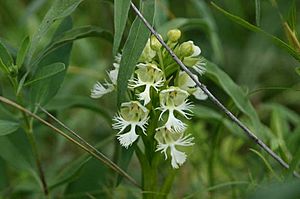Platanthera praeclara facts for kids
Quick facts for kids Platanthera praeclara |
|
|---|---|
 |
|
| Conservation status | |
| Scientific classification | |
| Genus: |
Platanthera
|
| Species: |
praeclara
|
| Synonyms | |
|
|
The western prairie fringed orchid (scientific name: Platanthera praeclara) is a very special and rare type of orchid. It is also sometimes called the Great Plains white fringed orchid. This beautiful flower grows naturally in North America.
Contents
Where This Orchid Lives
Long ago, the western prairie fringed orchid grew in many places. It was found in tallgrass prairies west of the Mississippi River. These areas stretched from southern Canada all the way down to northeast Oklahoma.
Today, you can still find this orchid in several states and one Canadian province. It lives in Iowa, Kansas, Manitoba (Canada), Minnesota, Missouri, Nebraska, and North Dakota.
What the Orchid Looks Like
The western prairie fringed orchid grows from a thick, fleshy root called a tuber. It can grow quite tall, usually from 38 to 85 centimeters (1 ft 3 in to 2 ft 9 in) high. Each plant can have many flowers, sometimes more than twenty, arranged along a tall stalk.
This orchid looks a lot like another type of orchid, the eastern prairie fringed orchid. However, the western one has slightly bigger flowers. Its petals are also shaped a bit differently, and it has a longer nectar spur. This spur is a part of the flower that holds nectar for pollinators.
Life Cycle and Habitat
The western prairie fringed orchid is a perennial plant, which means it lives for many years. It starts to grow in May and its flowers bloom in June or July, depending on how far north it is. The flowers smell wonderful at night. This scent helps attract large sphinx moths, which are important for pollinating the orchid.
This orchid loves to grow in tallgrass prairies. It needs lots of direct sunlight to grow well. You can often find it in wet areas or in meadows with lots of sedge plants. The orchid can even survive in places that have been lightly grazed by animals, burned sometimes, or mowed regularly. Scientists are still learning how these activities affect the plant. It might be good for the plant if dead grass is removed, but too much grazing can harm it.
Why This Orchid Needs Our Help
The western prairie fringed orchid is a threatened species. This means it is at risk of disappearing forever. In the United States, it has been listed as threatened since 1989. The International Union for the Conservation of Nature also listed it as an endangered species in 2008.
The biggest reason this orchid is in trouble is because its home, the native prairie, has been turned into farmland. Other things that have hurt the orchid include stopping natural fires, too much grazing by animals, and its habitat being broken up into smaller pieces.
In Canada, this orchid was listed as endangered in 2003. Even though the Canadian population is small, it is considered fairly stable. Groups like The Nature Conservancy of Canada are working hard to protect the places where this orchid lives. They have helped protect habitat for a large part of the world's western prairie fringed orchid population.


